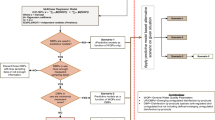Abstract
Maintaining clean drinking water is a key factor in maintaining sustainable development and a healthy environment. Thus, in many countries, the safety of drinking water is a key goal which is expected to be achieved in water distribution networks (WDNs). This experimental study was performed to assess the risks of E. coli bacterial intrusion into drinking WDNs. Three different scenarios are examined: (a) intrusion of E. coli bacteria during a sudden power shutdown associated with low or negative pressures; (b) planned intrusion through direct injection into the network using a high-pressure dosing pump; (c) premeditated or accidental E. coli contamination of water sources (tanks). While running the three scenarios, it was found that the rate at which bacteria reach customers is very comparable; however, higher risks are found with premeditated bacterial intrusion. The theory that contaminants immediately intrude into water networks through cracks and loose joints after a power shutdown accompanied by low/negative pressure was tested. It was found that there is a slim chance for E. coli and other contaminants to find a path into the system after sudden low/negative pressure events. High pressure within water networks pumps out water from the system, and then, the mixture (water and contaminants) is sucked back into the network if enough time is allowed after the power shuts down. Results show that it takes from 3.5–20 s for contaminants to intrude into the system after a sudden power outage if the network maintained an operating pressure between 1 and 4 bar prior to the shut down of the water pumps. This does not allow contaminants to enter the network unless there is a long-power shutdown that allows the contaminants to be sucked into the system. The minimum time required for contaminants to intrude into the system was found to depend on the water pressure prior to the power shut down. Meanwhile, it was found that bacteria directly injected to the system represent a major risk as it takes only 30–90 s for the contaminants to reach the customer at an operating pressure of 1–3 bar.
Similar content being viewed by others
References
Khanal, N.; Buchberger, S.G.; Mckenna, S.A.; Clark, R.M.; Grayman, W.M.: Vulnerability assessment of water distribution system to chemical intrusions. World Water Environ. Resour. Congr. 56, 1 (2005)
Kirmeyer, G.J.; Friedman, M.; Martel, K.D.; Noran, P.F.; Smith, D.: Practical guidelines FOR maintaining distribution system water quality. J. Am. Water Works Assoc. 93(7), 62–73 (2001)
Abo-Munasar, A.: Decision Support System for Risk and Water Quality Management in Water Distribution Network. King Fahd University of Petroleum and Minerals, Dhahran (2014)
Islam, N.; Farahat, A.; Al-Zahrani, M.A.M.; Rodriguez, M.J.; Sadiq, R.: Contaminant intrusion in water distribution networks: review and proposal of an integrated model for decision making. Environ. Rev. 23(3), 337–352 (2015)
Isovitsch, S.; Vanbriesen, J.: Sensor placement and optimization criteria dependencies in a water distribution system. J. Water Resour. Plan. Manag. 134(2), 186–196 (2008)
LeChevallier, M.W.; Babcock, T.M.; Lee, R.G.: Examination and characterization of distribution system biofilms. Appl. Environ. Microbiol. 53(12), 2714–2724 (1987)
Douterelo, I.; Boxall, J.B.; Deines, P.; Sekar, R.; Fish, K.E.; Biggs, C.A.: Methodological approaches for studying the microbial ecology of drinking water distribution systems. Water Res. 65, 134–156 (2014)
Pirnie, M.; Szewzyk, U.; Szewzyk, R.; Manz, W.; Schleifer, K.H.: Microbiological safety of drinking water. Annu. Rev. Microbiol. 54, 81–127 (2000)
Hellard, M.E.; Sinclair, M.I.; Hogg, G.G.; Fairley, C.K.: Prevalence of enteric pathogens among community based asymptomatic individuals. J. Gastroenterol. Hepatol. 15(3), 290–293 (2000)
Somashekar, K.M.; Mahima, M.R.; Manjunath, K.C.: Contamination of water sources in Mysore City by pesticide residues and plasticizer—a cause of health concern. Aquat. Proc. 4, 1181–1188 (2015)
Admassu, M.; Wubshet, M.; Gelaw, B.: A survey of bacteriological quality of drinking water in North Gondar. Ethiop. J. Heal. Dev. 18(2), 113–135 (2004)
Qu, X.; Alvarez, P.J.J.; Li, Q.: Applications of nanotechnology in water and wastewater treatment. Water Res. 47(12), 3931–3946 (2013)
Edberg, S.C.; Rice, E.W.; Karlin, R.J.; Allen, M.J.: Escherichia coli: the best biological drinking water indicator for public health protection. J. Appl. Microbiol. 88(S1), 106S–116S (2000)
Hellard, M.E.; Sinclair, M.I.; Forbes, A.B.; Fairley, C.K.: A randomized, blinded, controlled trial investigating the gastrointestinal health effects of drinking water quality. Environ. Health Perspect. 109(8), 773–778 (2001)
Murphy, H.M.; Thomas, M.K.; Schmidt, P.J.; Medeiros, D.T.; McFadyen, S.; Pintar, K.D.M.: Estimating the burden of acute gastrointestinal illness due to Giardia, Cryptosporidium, Campylobacter, E. coli O157 and norovirus associated with private wells and small water systems in Canada. Epidemiol. Infect. 144(7), 1355–1370 (2016)
Douterelo, I.; Boxall, J.B.; Deines, P.; Sekar, R.; Fish, K.E.; Biggs, C.A.: Methodological approaches for studying the microbial ecology of drinking water distribution systems. Water Res. 65, 134–156 (2014)
Lin, Y.W.; Li, D.; Gu, A.Z.; Zeng, S.Y.; He, M.: Bacterial regrowth in water reclamation and distribution systems revealed by viable bacterial detection assays. Chemosphere 144, 2165–2174 (2016)
Prest, E.I.; Hammes, F.; Kötzsch, S.; Van Loosdrecht, M.C.M.; Vrouwenvelder, J.S.: A systematic approach for the assessment of bacterial growth-controlling factors linked to biological stability of drinking water in distribution systems. Water Sci. Technol. Water Supply 16(4), 865–880 (2016)
Gorchev, H.G.; Ozolins, G.: WHO guidelines for drinking-water quality. WHO Chron. 38(3), 104–108 (2011)
Besner, M.; Prévost, M.; Regli, S.: Assessing the public health risk of microbial intrusion events in distribution systems: conceptual model, available data, and challenges. Water Res. 45(3), 961–979 (2011). https://doi.org/10.1016/j.watres.2010.10.035
Moe, C.L.; Rheingans, R.D.: Global challenges in water, sanitation and health.pdf. J. Water Health 4(1), 41–57 (2006)
Author information
Authors and Affiliations
Corresponding author
Rights and permissions
About this article
Cite this article
Farahat, A., Mahmoud, M.T. & Khalil, A. Assessment of the Risk Associated with E. coli Bacterial Intrusion in Drinking Water Distribution Networks. Arab J Sci Eng 44, 4161–4168 (2019). https://doi.org/10.1007/s13369-018-3344-6
Received:
Accepted:
Published:
Issue Date:
DOI: https://doi.org/10.1007/s13369-018-3344-6




